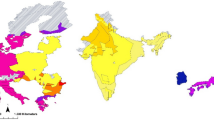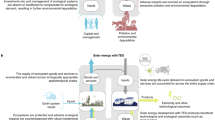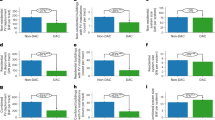Abstract
The deployment of renewable energy systems, such as solar energy, to achieve universal access to electricity, heat and transportation, and to mitigate climate change is arguably the most exigent challenge facing humans today1,2,3,4. However, the goal of rapidly developing solar energy systems is complicated by land and environmental constraints, increasing uncertainty about the future of the global energy landscape5,6,7. Here, we test the hypothesis that land, energy and environmental compatibility can be achieved with small- and utility-scale solar energy within existing developed areas in the state of California (USA), a global solar energy hotspot. We found that the quantity of accessible energy potentially produced from photovoltaic (PV) and concentrating solar power (CSP) within the built environment (‘compatible’) exceeds current statewide demand. We identify additional sites beyond the built environment (‘potentially compatible’) that further augment this potential. Areas for small- and utility-scale solar energy development within the built environment comprise 11,000–15,000 and 6,000 TWh yr−1 of PV and CSP generation-based potential, respectively, and could meet the state of California’s energy consumptive demand three to five times over. Solar energy within the built environment may be an overlooked opportunity for meeting sustainable energy needs in places with land and environmental constraints.
This is a preview of subscription content, access via your institution
Access options
Subscribe to this journal
Receive 12 print issues and online access
$209.00 per year
only $17.42 per issue
Buy this article
- Purchase on Springer Link
- Instant access to full article PDF
Prices may be subject to local taxes which are calculated during checkout


Similar content being viewed by others
References
IPCC Special Report: Renewable Energy Sources and Climate Change Mitigation (Cambridge Univ. Press, 2011)
IPCC Climate Change 2014: Impacts, Adaptation, and Vulnerability. Part A: Global and Sectoral Aspects (Cambridge Univ. Press, 2014)
Hoffert, M. I. et al. Advanced technology paths to global climate stability: Energy for a greenhouse planet. Science 298, 981–987 (2002).
Barthelmie, R. J. & Pryor, S. C. Potential contribution of wind energy to climate change mitigation. Nature Clim. Change 2035, 8–12 (2014).
Dale, V. H., Efroymson, R. A. & Kline, K. L. The land use–climate change–energy nexus. Landsc. Ecol. 26, 755–773 (2011).
Hernandez, R. R. et al. Environmental impacts of utility-scale solar energy. Renew. Sustain. Energy Rev. 29, 766–779 (2014).
Cameron, D. R., Cohen, B. S. & Morrison, S. A. An approach to enhance the conservation-compatibility of solar energy development. PLoS ONE 7, 1–12 (2012).
Ando, A., Camm, J., Polasky, S. & Solow, A. Species distributions, land values, and efficient conservation. Science 279, 2126–2128 (1998).
Schultz, P. W. et al. Values and their relationship to environmental concern and conservation behavior. J. Cross. Cult. Psychol. 36, 457–475 (2005).
Carbajales-Dale, M., Barnhart, C. J., Brandt, A. R. & Benson, S. M. A better currency for investing in a sustainable future. Nature Clim. Change 4, 524–527 (2014).
Gaffin, S. R., Rosenzweig, C. & Kong, A. Y. Y. Adapting to climate change through urban green infrastructure. Nature Clim. Change 2, 704 (2012).
Hernandez, R. R., Hoffacker, M. K. & Field, C. B. Land-use efficiency of big solar. Environ. Sci. Technol. 48, 1315–1323 (2014).
International Energy Agency, World Energy Outlook 2013 1–671 (International Energy Agency, 2013).
Van Vuuren, D. et al. An energy vision: the transformation towards sustainability—interconnected challenges and solutions. Curr. Opin. Environ. Sustain. 4, 18–34 (2012).
Fluri, T. P. The potential of concentrating solar power in South Africa. Energy Policy 37, 5075–5080 (2009).
Domínguez Bravo, J., García Casals, X. & Pinedo Pascua, I. GIS approach to the definition of capacity and generation ceilings of renewable energy technologies. Energy Policy 35, 4879–4892 (2007).
Stoms, D. M., Dashiell, S. L. & Davis, F. W. Siting solar energy development to minimize biological impacts. Renew. Energy 57, 289–298 (2013).
Loarie, S. R. et al. The velocity of climate change. Nature 462, 1052–1055 (2009).
Miller, N. L., Hayhoe, K., Jin, J. & Auffhammer, M. Climate, extreme heat, and electricity demand in California. J. Appl. Meteorol. Climatol. 47, 1834–1844 (2008).
Allison, T. D., Root, T. L. & Frumhoff, P. C. Thinking globally and siting locally—renewable energy and biodiversity in a rapidly warming world. Climatic Change 126, 1–6 (2014).
Armstrong, A., Waldron, S., Whitaker, J. & Ostle, N. J. Wind farm and solar park effects on plant-soil carbon cycling: Uncertain impacts of changes in ground-level microclimate. Glob. Change Biol. 20, 1699–1706 (2014).
California Energy Commission Renewable Power in California: Status and Issues 1–282 (California Energy Commission, 2011); http://www.energy.ca.gov/2011publications/CEC-150-2011-002/CEC-150-2011-002.pdf
Fry, J. et al. Completion of the 2006 national land cover database for the conterminous US. Photogramm. Eng. Remote Sens. 77, 858–864 (2006).
California Energy Commission Tracking Progress: Renewable Energy – Overview 1–18 (California Energy Commission, 2014); http://www.energy.ca.gov/renewables/tracking_progress/documents/renewable.pdf
California Energy Commission, New Renewable Generation Needed to Comply with Policy Goals: Update for 2022 Planning 1–25 (California Energy Commission, 2013).
Paidipati, J., Frantzis, L., Sawyer, H. & Kurrasch, A. Rooftop Photovoltaics Market Penetration Scenarios (National Renewable Energy Laboratory, 2008).
San Francisco, D. of the E. CH2M Hill. San Francisco Energy Map (2013)
Bazilian, M. et al. Re-considering the economics of photovoltaic power. Renew. Energy 53, 329–338 (2013).
Cook, T. R. et al. Solar energy supply and storage for the legacy and nonlegacy worlds. Chem. Rev. 110, 6474–6502 (2010).
Drury, E. & Lopez, A. Relative performance of tracking versus fixed tilt photovoltaic systems in the USA. Prog. Photovolt. 22, 1302–1315 (2013).
Acknowledgements
The McGee Research Grant of Stanford’s School of Earth Sciences, the TomKat Center for Sustainable Energy, the Jean Langenheim Research Fellowship of Graduate Women in Science Society, the Hispanic Scholarship Fund’s William Randolph Hearst Fund Scholarship, and the Vice Provost Office of Graduate Education’s Diversifying Academia, Recruiting Excellence Program provided financial support for this study. We thank M. Tavassoli who contributed to the data collection and N. Alvarez who assisted with several spatial analyses. We thank L. White who contributed to graphic design.
Author information
Authors and Affiliations
Contributions
R.R.H. conceived the project, R.R.H. developed the model, R.R.H. and M.K.H. conducted analyses and model runs, and R.R.H., M.K.H. and C.B.F. wrote the paper.
Corresponding author
Ethics declarations
Competing interests
The authors declare no competing financial interests.
Supplementary information
Rights and permissions
About this article
Cite this article
Hernandez, R., Hoffacker, M. & Field, C. Efficient use of land to meet sustainable energy needs. Nature Clim Change 5, 353–358 (2015). https://doi.org/10.1038/nclimate2556
Received:
Accepted:
Published:
Issue Date:
DOI: https://doi.org/10.1038/nclimate2556
This article is cited by
-
Grassland carbon-water cycling is minimally impacted by a photovoltaic array
Communications Earth & Environment (2023)
-
U.S. national water and energy land dataset for integrated multisector dynamics research
Scientific Data (2022)
-
The potential land requirements and related land use change emissions of solar energy
Scientific Reports (2021)
-
Urban renewable energy and ecosystems: integrating vegetation with ground-mounted solar arrays increases arthropod abundance of key functional groups
Urban Ecosystems (2021)
-
Significantly enhanced energy harvesting based on Ba(Ti,Sn)O3 and P(VDF-CTFE) composite by piezoelectric and triboelectric hybrid
Journal of Materials Science: Materials in Electronics (2021)



